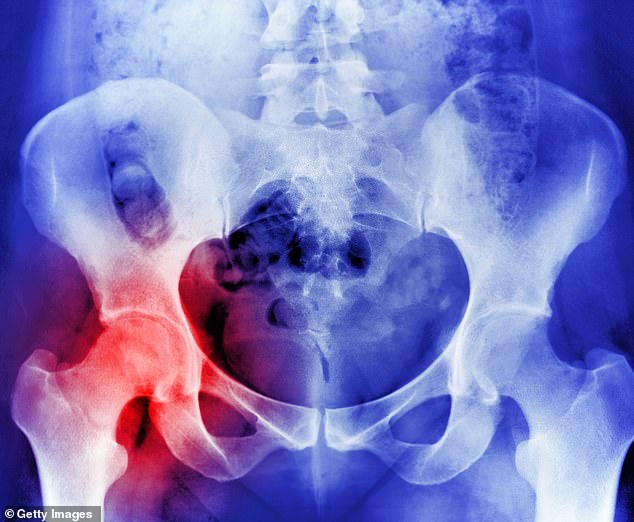Q: I had a mini stroke three years ago and was prescribed a bunch of tablets, including lansoprazole. After suffering from pain in my legs and hips, a scan revealed that I have early stage osteoporosis. I have read that lansoprazole could be a cause. Should I stop taking it?
Dr. Ellie answers: Lansoprazole is a type of medicine known as a proton pump inhibitor or PPI. These work by reducing the amount of acid produced in the stomach and for this reason are given to people with acid reflux, stomach ulcers and gastritis.
They can also be prescribed preventively for people taking other medications that can irritate the stomach, for example, if someone is taking a regular anti-inflammatory.
But all medications carry side effects and risks that must be balanced with the need to take them.
According to official guidelines, PPIs should be prescribed with caution to people at risk of osteoporosis, a bone-thinning disease. Patients should be counseled about taking medications and offered calcium and vitamin D supplements (and sometimes other treatments) to prevent problems from developing.
An x-ray showing osteoporosis resulting in a hip replacement
Osteoporosis makes people susceptible to fractures. Studies published more than a decade ago showed that older people who took PPIs, especially for more than a year, had a higher risk of breaking their hip, wrist or spine. These effects were more likely with higher doses and the longer people took them.
Contrary to popular belief, the symptoms of osteoporosis are not stiffness or night pain. In fact, there are usually no signs until a fracture occurs and the disease is diagnosed by examination.
An older person who is taking a PPI and has been diagnosed with osteopenia (a warning sign of osteoporosis) may request a scan to evaluate the situation. If bone thinning continues to be a problem, it may be possible to switch to other medications.
Q: At night, I often wake up with extreme pain under the arch of my foot. I went to the podiatrist and tried several creams. Can you suggest something? I should point out that five years ago I had a brain tumor removed and had a hemorrhage on my brain.
Dr. Ellie answers: Severe heel pain is usually caused by a condition called plantar fasciitis. However, this causes pain when walking during the day and will improve once you rest. Foot pain can be a side effect of cancer treatment, particularly chemotherapy, which can damage nerves.
The pain may be worse at night due to the increased temperature of the feet, some swelling from being still, and also because there are no distractions. Creams or paracetamol are unlikely to help with this.
To evaluate the neurological cause of the pain (specifically peripheral neuropathy, which is a form of nerve damage), tests called nerve conduction studies may be performed in the hospital. A GP should be able to refer you for this.
If the problem is nerves, this pain will not respond to normal pain relievers, but will require a neuropathic pain reliever, such as gabapentin or pregabalin.
We also use an older antidepressant called amitriptyline, which can also help with sleep.
Q: I was diagnosed with breast cancer and successfully treated in 2018, at age 67. I am now 72 years old and at my last appointment they told me I would have a mammogram once every three years, and that’s it. Is this really safe? I would prefer to continue having one every year, as until now.
Dr. Ellie answers: Mammograms are a type of x-ray that we use to detect breast cancer. The idea is to detect lumps when they are small, before they can be felt.
In the UK, women aged 50 to 70 are screened once every three years. From the age of 70, women can request to have them every three years.
This is believed to be the best timeframe because offering mammograms too frequently increases the risk of false positives and all the anxiety that comes with that. It also does not provide any benefit in terms of better protection or longer life.
Screening tests are only for people who are well. For women who have had breast cancer, the situation is, of course, different. Initially, annual mammograms are the normal procedure for five years, usually along with pill treatment.
At this stage, women re-enter the regular screening program. This system mirrors the treatment of other cancers. The five-year milestone is typically the point at which we consider a patient cured. Most cancers, if they are going to come back, do so before this time.
Five years after diagnosis, women who have had breast cancer receive the same treatment as other women their age who have not had it. This can be quite difficult, although many patients are happy to return to their normal lives and not remember their diagnosis.
However, it is important for women to understand that if they have symptoms such as a lump, pain or changes in the breast, the screening program is irrelevant. If you have symptoms, go to your GP and he or she will organize tests for you that are completely independent of the program.

Lady Gaga posted a video about rimegepant migraine treatment on Instagram. She says the drug has changed her life.
Lady Gaga got help for her migraines… but what about you?
Big migraine news as the NHS spending watchdog approved atogepant, a daily tablet that helps prevent debilitating attacks.
Meanwhile, in the United States, Lady Gaga announces a similar new migraine treatment, rimegepant, which she says has changed her life.
But patients in the UK will have to try three other drugs before receiving atogepant (also known by the brand name Aquipta) and it can only be prescribed by a specialist, not a GP. Then there are waits of up to a year to see a neurologist in some areas – and that’s if your NHS provider will fund the £500-a-month treatment.
Reports suggest there is a zip code lottery when it comes to migraine treatments. Have you had difficulties accessing them? Please write to me and let me know.
A stoma without baggage
I had never heard of Louise Thompson until last week, when the Made In Chelsea star announced that after years of suffering from ulcerative colitis, a painful bowel problem, she had been fitted with a stoma bag.
In a video she posted on Instagram, the 34-year-old said she “didn’t want to hide” her condition and that the bag “might as well have saved my life.” She applauded her honesty.
Having a stoma is a big problem. There are around 100,000 people in Britain with one – usually as a result of Crohn’s disease, bowel cancer or infections – but there is still a stigma around it. Some people become very isolated and don’t do things they used to enjoy for fear of getting hurt, making a mess, or having people see the bag.
But life with a stoma doesn’t have to change. Colostomy UK is a good source of advice and can direct you to support groups (colostomyuk.org).
Do you have any questions for Dr. Ellie Cannon? Email DrEllie@mailonsunday.co.uk
Dr. Cannon cannot engage in personal correspondence and her responses should be taken in a general context.


